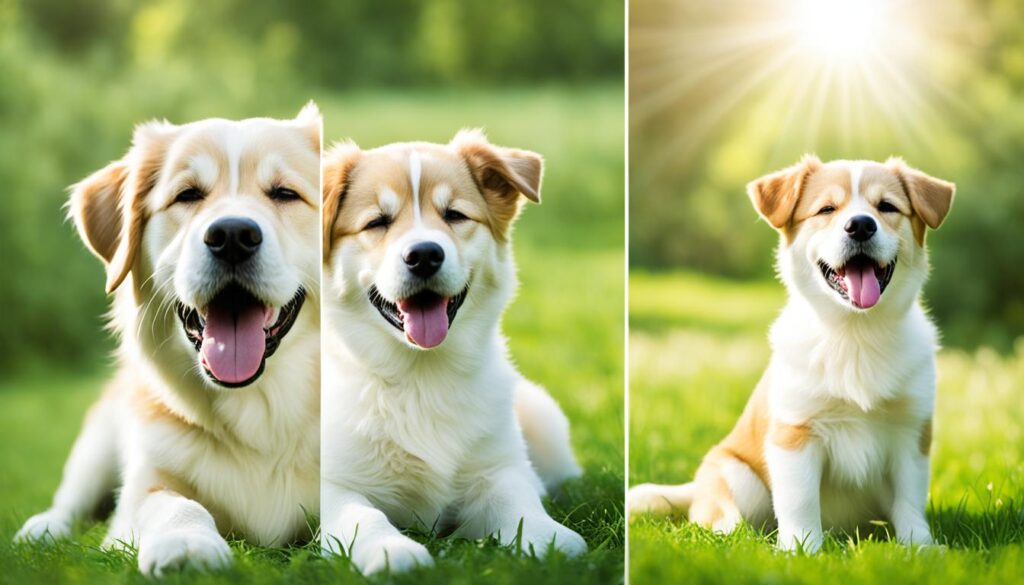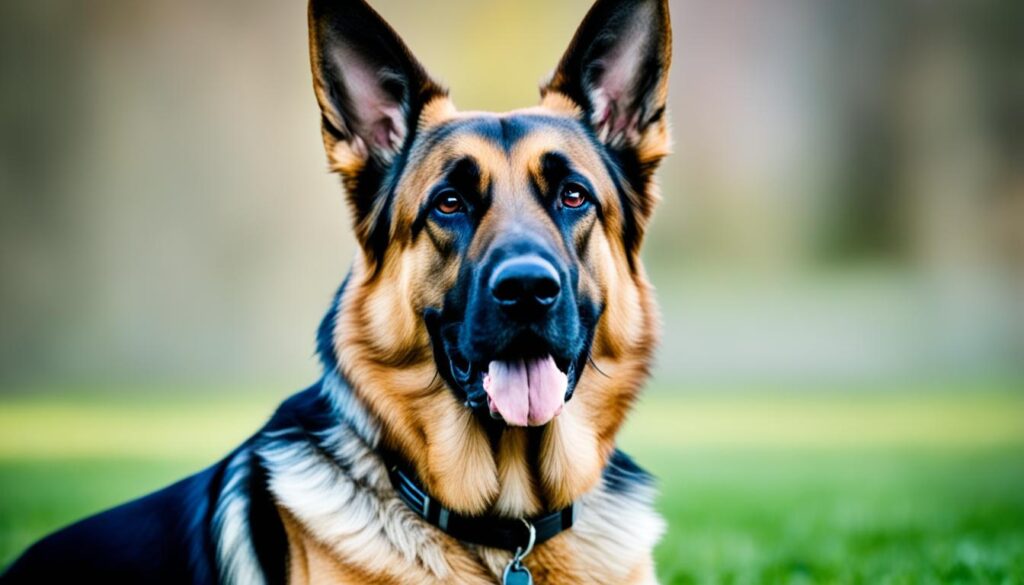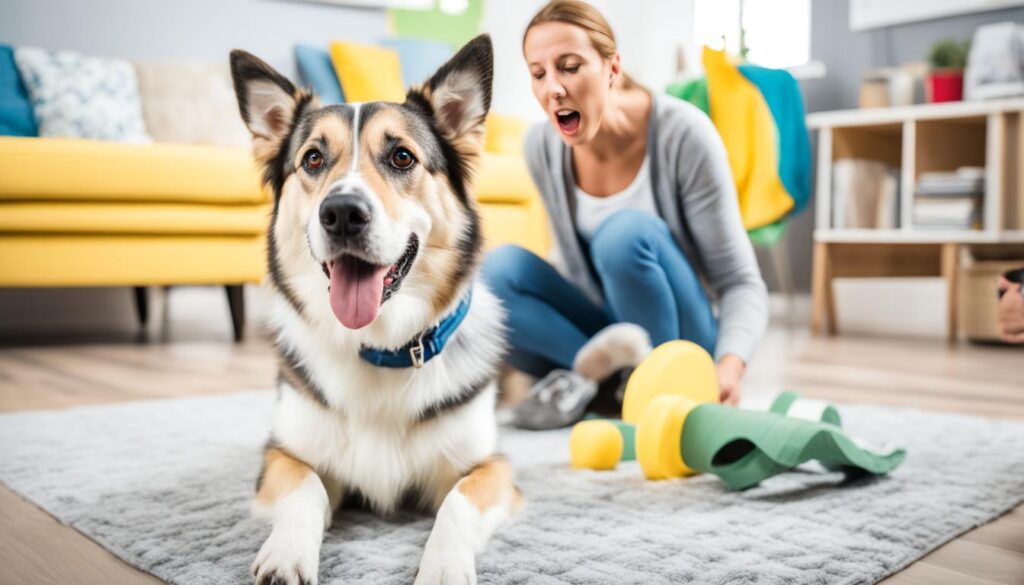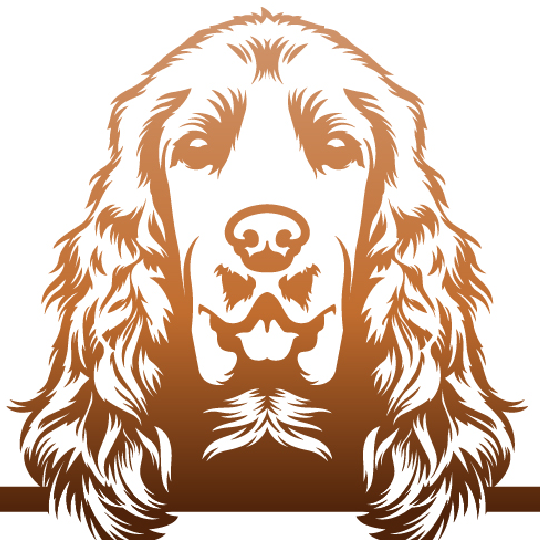Since 2020, I’ve walked city streets, getting to know stray dogs. I’ve learned about their secret signals. A collar and tag are more than accessories; they’re key to getting lost dogs back home.
Dog body language is like their way of chatting. They’re not talking about other dogs though. Watch for signs like yawning and lip-licking. They tell you if your dog is feeling chill or not. Learn these dog communication cues. It’ll help you understand them better.
Understanding Your Dog’s Communication Cues
As a dog parent, I always try to figure out what my dog is thinking. It’s about more than just seeing their behaviors. Every tail wag, sniff, and yawn means something special in dog language. So, let’s explore the meanings behind our dogs’ actions together.
When my dog’s tail wags really fast, it’s like he’s super happy. It’s as if he’s saying he’s excited in all caps. But, if his tail is moving slow and low, he might be feeling unsure or cautious.
Seeing my dog’s tail tucked under is a big sign he’s not okay. It’s like he’s super stressed out. If his tail is down and not moving much, he might be worried. It’s his way of showing that something’s wrong.
I’ve learned that a dog’s tail shows how they’re feeling, from happy to scared. Yawns don’t always mean they’re tired. Sometimes, it’s a sign they’re feeling stressed or anxious.
If my dog sniffs around a lot, it might mean he’s nervous. This is his way of trying to figure things out. Barking, whining, growling, and howling all tell us how he’s feeling, from wanting attention to asking for space.
Dogs have calming signals, like licking their lips or yawning. These mean they’re trying to stay relaxed. Even shaking off can be more about calming down than about fleas.
Remember, when dogs meet, it’s best to go one at a time. This keeps them from feeling overwhelmed, kind of like superheros meeting each other gently.
Knowing what your dog’s signals mean helps us take better care of them. It can even save money on vet bills. So, let’s stay alert to our dogs’ needs and keep them happy.
| Behavior | Emotion Signal | Examples |
|---|---|---|
| High Fast Tail Wag | Excitement/Happiness | Meeting favorite humans, playtime initiation |
| Slow Low Tail Wag | Caution/Uncertainty | Unfamiliar environments, new pet introductions |
| Tail Tucked, Slow Wag | Stress/Fear | Thunderstorms, tense situations |
| Yawning | Stress/Anxiety | During vet visits, conflict scenarios |
| Increased Sniffing | Stress/Anxiety | Changes in the household, presence of strangers |
| Different Vocalizations | Various Emotions/Intentions | Barking at doorbell, whining when alone |
Interpreting the Unspoken Language of Canines
Dogs communicate in ways we’re just beginning to understand. Like learning a new language, each dog action tells us something special. This means, without speaking, they show their feelings through movement. Most of our human chatting isn’t through words either. Imagine a world where all talking is done without voice. That’s how it is for dogs.

Studies on dogs show how important their silent messages are. For example, research by Udell M.A. and Wynne C.D. (2008) talks about dogs acting like humans. Another study by Range F. and Viranyi Z. (2012) explores how taming dogs has changed their thinking. This shows how closely linked humans and dogs are in their actions and history.
Think about how quickly we judge others. Dogs are even better at it. Our first impressions are made fast, based on what we see and hear. For dogs, a small change in their body or tail can express fear, happiness, anger, or playfulness.
Is a tail-wagging dog always happy? Not necessarily. Soproni K. and others in 2002 found that dogs understand human pointing, showing they’re quite smart. And Quaranta A. and their team in 2007 learned that dogs wag their tails in different ways for different reasons. Isn’t that interesting?
Svartberg K. in 2006 asked if breed-specific behaviors matter today. This raises a good point. Ignoring these non-verbal hints means we could miss over half of what dogs are trying to say.
| Author(s) | Focus of Study | Year | Key Insight |
|---|---|---|---|
| Udell M.A., Wynne C.D. | Human-like behaviors | 2008 | Understanding empathy |
| Range F., Viranyi Z. | Effect of domestication | 2012 | Cognitive capabilities |
| Soproni K. et al. | Responsiveness to gestures | 2002 | Communication precision |
| Bradshaw J., Nott H. | Social behavior | 1995 | Inter-dog relations |
| Quaranta A. et al. | Asymmetric tail-wagging | 2007 | Emotion revealing nuances |
Getting to know dog language is not just fun, it’s key for a stronger bond. People like Overall K.L. (1997) and Pamela J.R. (1996) help us see how much there is to learn. By paying attention to their quiet signals, we can build a deeper friendship.
Charles Darwin’s work in 1872 was groundbreaking. It led us to see the importance of body language in all creatures. By understanding these silent messages, we grow closer to our canine friends. It turns into a silent, deep bond.
What Stress Signals in Dogs Can Tell You
Our furry friends are more than pets; they’re family. And like family, they don’t always tell us how they feel. But, thanks to Turid Rugaas, we know dogs talk through calming signals in canine behavior. They have over 30 ways to show us their feelings. So, when they show dog anxiety signals, they’re really trying to communicate with us.
Your dog pacing could mean they’re stressed or anxious. Dogs looking at you sadly might be their way of saying they’re stressed. These signs can be their eyes going wide, ears standing up, or tails tucking under. And don’t miss other signs like unexpected lip licking, yawning, or panting that has nothing to do with exercise.
Understanding these signals needs us to be intuitive. A study found dogs showed 2,130 calming behaviors in dogs when meeting new dogs. These actions, like turning their head or licking their lips, happen more with unfamiliar dogs than buddies. It’s their way of handling awkward moments.
Most calming actions occur up close, about one and a half doggy lengths apart. It’s like they’re having a quiet conversation. When disagreements arise, calm usually returns with one of these gestures. After a fight, there’s a good chance for peacemaking moves. But, there’s always one dog that keeps the conflict going, just like in any group.
- Find what bothers your dog and keep it away, like that loud vacuum cleaner.
- Seek professional help to understand your dog’s anxiety better.
- Create a stress-free zone for your dog to relax in.
Dogs signal when they’re stressed or need a break, and we should listen. I’m learning to decipher these signals to understand my dog better. I aim for genuine happiness, a stress-free environment, and fluency in ‘dog’. Let’s commit to understanding our dogs through their licks, yawns, and looks. They deserve our effort to comprehend their language.
30 Calming Signals for Dogs

I’m really into dogs and how they share their feelings without words. Especially through calming signals in canine behavior. Did you know pups start to yawn to calm down just hours after they’re born? This small act shows how naturally they communicate through dog communication cues.
From what I’ve learned, especially from dog expert Turid Rugaas, we can understand their silent language. By using 30 calming signals for dogs ourselves, we can actually talk back. This helps us get closer to our furry friends.
But it’s not always easy for them to show these 30 calming signals for dogs. If they’re not used to being around others, it can be harder. Also, being on a short leash can make them uncomfortable. This stops them from showing their calming signs well.
Now, let’s look at some common calming signals. These include quick lip licks and more noticeable actions like turning their whole body. Each sign is their way of avoiding trouble and saying, “Let’s stay calm.”
| Calming Signal | Behavior Description | Typical Situations |
|---|---|---|
| Yawning | A signal of stress in situations like loud arguments or vet visits. | Trainer sessions, high-tension environments |
| Licking Lips | Communicates to others that there’s no threat of attack. | Approached by other dogs, human interaction |
| Turning Head Away | Range from a slight turn to 90 degrees to avoid conflict. | Meeting new dogs, uncomfortable situations |
| Play Bow | Invites play or diffuses tense situations between dogs. | First encounters with other dogs |
| Sniffing the Ground | Behavior seen in puppies in new environments to self-calm. | New or intimidating situations |
| Moving Slowly | Indicates insecurity, often mistaken for stubbornness. | Feeling anxiety or stress |
| Freezing | Stopping perceived aggressive behavior from others. | Threatening encounters with dogs/humans |
| Walking in Curves | Moving in a curved path to indicate unease and insecurity. | Lowering threat levels in interactions |
Knowing these calming signals helps us support our pets when they’re stressed. If you see your dog showing one, they may need some alone time. Remember, every signal is part of a big chat your dog is trying to have with everything around them.
Here’s to better talks, more happy tail wags, and less stress – because understanding calming signals for dogs is more than just facts. It’s speaking the language of love.
Calming Signals and Dog-to-Dog Interaction

Imagine two dogs meeting for the first time with me observing. I know a bit about calming signals in canine behavior and dog-to-dog communication. It feels like listening in on a secret conversation in Furtown. Every move they make can change how they get along. It’s like a high-stakes game where sniffs and respect are on the line. Now, onto some facts.
| Calming Signal | Frequency | Effect on Dog-to-Dog Interaction |
|---|---|---|
| Head-Turning | High | Averts potential conflict |
| Lip Licking | High | Calms when in closer proximity |
| Freezing | Common | De-escalates tension |
| Turning Away | Common | Signals disinterest in conflict |
Turid Rugaas revealed a lot with her book on calming signals in canine behavior. Chiara Mariti added more with a study on 24 dogs. She showed over 2,130 times dogs used peace signals. Avoiding trouble or gently lip licking when space gets tight, it’s about harmony. Just one signal can cool down 67% of dog arguments. That’s amazing compared to people’s arguments!
Some dogs, however, don’t catch on to these signals. They remind us of people who miss social cues. Chiara noticed one such dog, ignoring signals like someone avoiding a call. Domestic dogs usually prefer peace, using signals to avoid conflict. They’re more peaceful than wild dogs.
Important for parents: kids under six often miss these dog cues. It’s crucial to teach them about dog-to-dog communication early. These signals are vital for peace during playtime and keep dog parks joyful.
Mel from “All For Furry Friends” Shares Dog Behavior Insights
Hey there, fellow dog lovers! It’s me, your go-to guide for all things dog. I’ve been walking dogs along the sunny Gold Coast. I work with Gold Coast dog walking company, All For Furry Friends. Every walk teaches me something new about how dogs communicate.

Turid Rugass knows dog communication well. She talks about over 30 calming signals dogs show us. These signals tell us how they’re feeling, without any words.
- Yawning isn’t just for sleepy times. It can mean your dog is stressed or anxious.
- A lick can be more than tasting your lunch. It’s a sign of peace towards other dogs.
- If your dog looks away, they’re not distracted. They’re trying to calm down a tense situation.
Ever seen a dog bow before playing? It’s their way of breaking the ice peacefully. Sniffing the ground or walking slowly? They’re not just curious. These actions help them stay relaxed.
When your dog freezes, they’re sensing danger. It’s like they’re saying, “Stop right there!” But if they approach someone or another dog in a zigzag, they’re trying to be friendly.
I, Mel from All For Furry Friends, believe in understanding these signals. When we respond with kindness, we make our bond stronger. It turns our relationship into a beautiful love story. So, watch for these cues during walks. They show your dog’s feelings and needs.
How to Respond to Your Dog’s Calming Signals
Imagine this scene: you’re busy with your day and your dog yawns widely, but it’s not time for sleep. This yawn could be one of dog anxiety signals your pet uses to say, “I’m feeling stressed.” It’s not about the air tasting good; it’s a key way they communicate.
As a knowledgeable dog owner, reacting to these stress signals in dogs positively builds a strong bond. Seeing your dog flick its tongue means more than you think. It’s like your dog holding up a sign saying “I’m nervous.” It tells you they need a break, not that they’re hungry or there’s something on their nose.
Understanding your dog goes beyond their barks and tail movements. According to Alexandra Bassett, a dog behavior expert in Los Angeles, if your dog sits or lies down, they might need a pause from their surroundings. If they stop walking suddenly, they’re not being difficult. They’re asking for a break from the stress.
What should a dog owner do? Act like a dog whisperer by giving them space, both physically and mentally. Lower the noise around them, speak softly, and maybe take them somewhere quieter. Remember, positive reinforcement isn’t just treats. It’s about understanding and patience, which are equally rewarding.
| Calming Signal | Meaning | How to Respond |
|---|---|---|
| Tongue flicks | Anxiety or uncertainty | Offer a break or distraction |
| Yawning | Stress or desire for change | Introduce a calming activity or change of environment |
| Sitting/Lying Down | Calming a threat or discomfort | Acknowledge the signal, give space and a calm atmosphere |
At the end of the day, noticing and reacting to your dog’s stress signals is about listening well. Stay alert for those signals and let your actions speak. This silent communication might become the most meaningful conversation you have with your dog all day.

The Connection Between Dog Anxiety Signals and Health
Studying dog behavior is more than a hobby; it’s key to spotting their health problems. When dogs show anxiety signals, it’s not just a bad mood. These signs might mean they need a vet.
A study found that dogs’ stress relates to their relationship with humans and their personalities. If Zara, my beagle, suddenly loses energy or doesn’t eat, I pay attention. These changes could mean he’s uncomfortable or sick.
Human interaction also affects a dog’s stress levels. Spending time with my dog reduces his anxiety. Grooming or massaging Zara boosts our bond and his focus, evident in his brain waves.
- Playing reduces stress for both of us!
- I must understand dog anxiety signals to help him.
- Watching for odd behavior is crucial for their well-being.
I’m not a vet, but I keep an eye out for signs of trouble from Zara. A strange paw move or a missed tail wag could mean he needs help.

Health care workers, including animal caregivers, talk about “compassion fatigue.” This stress affects humans and dogs. If a dog’s heart beats irregularly, it’s a sign of stress. We need to understand what their whimpers or chewing means.
Our emotions affect our dogs, and theirs affect us. As their guardians, we must notice and respond to their silent signals. It’s about keeping them healthy and our relationship strong. The goal is to interpret dog behavior for their health, not just to show off at the dog park.
Conclusion
We’re nearing the end of our journey into the world of dog behavior. It’s obvious that a good relationship with our dogs depends on how well we understand their signals. Dogs use calming signals, like turning their heads or licking their noses, to talk to us. These actions show how smart dogs are and how their social skills have developed over thousands of years.
It’s important to not just love our dogs but to also be aware of their needs. Knowing the difference between a happy wag and a scared tail tuck is key. Understanding their signals can help us live better together. Teaching kids these signals can also make things safer for them and the dogs.
Remember, when a dog looks away or lifts a paw, they are trying to communicate with us. They want us to listen and understand them. By paying attention to these signals and responding kindly, we show we care. Getting better at understanding our dogs is not just for fun. It’s a way to truly connect with our loyal friends who enrich our lives.




